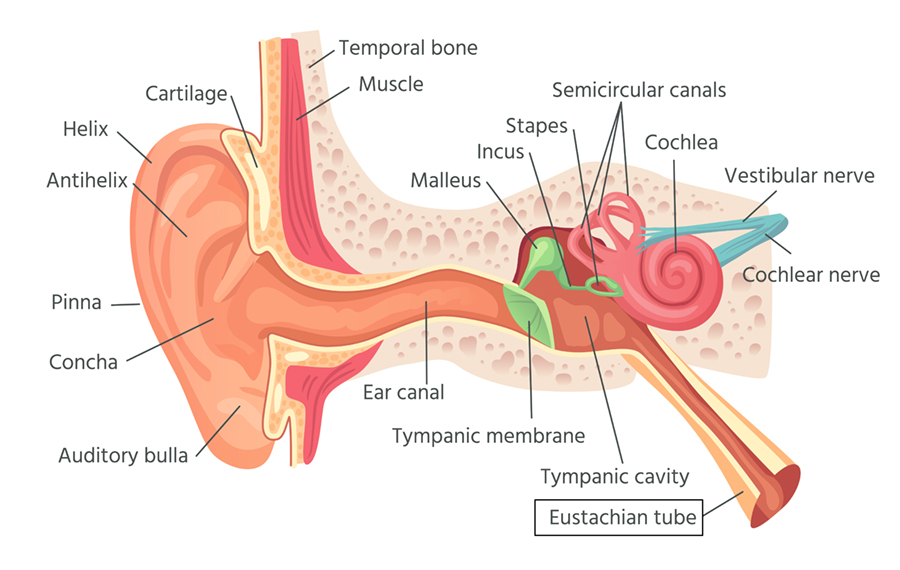Experience clear sound, clear head, and a bright future with Eustachian Tube Dysfunction Treatment

If you have experienced the discomfort of muffled hearing, plugged ears, a popping sensation, or pain in the ears, then it may be due to Eustachian Tube Dysfunction (ETD). Eustachian Tube Dysfunction in adults and children of all ages is common and usually clears up on its own, but when it begins to take away the joys of life then it must be addressed.
Eustachian Tube Dysfunction can impact anyone, but for those who enjoy work or hobbies that take them underwater or at high altitudes, the pain and suffering can be uncomfortable and dangerous. Scuba divers, pilots, flight attendants, and those who enjoy recreational flying, snow skiing, mountain climbing and other hobbies are particularly vulnerable.
What is Eustachian Tube Dysfunction (ETD)?
The eustachian tube is a narrow passageway that connects the back of the nasal passage with the middle ear. It is responsible for a number of very important bodily functions that usually go unnoticed until they stop working correctly. These tubes allow air to flow to the middle ear on the back side of the eardrum. This air equalizes the air pressure on the ear drum which allows for sound clarity and prevents damage. It also plays an important role in protecting the middle ear from infection as well as draining the inner ear and preventing ear infections.
In children, these tubes are shorter and have a flatter angle which makes draining the middle ear more difficult. This is why many children have chronic ear infections that must be addressed.
Eustachian tube dysfunction causes any of these main functions to be disrupted resulting in common symptoms such as:
- Plugged Ears
- Muted or Muffled Sound
- Clicking or Popping Feeling or Sound (children may describe a “tickling” sensation)
- Ear Pain
- Physical Imbalance
- Ringing Sounds (tinnitus)
For those whose work or hobbies bring them underwater or at high altitudes, these symptoms may be more frequent and intense. In addition, simple tasks such as riding an elevator, driving through mountainous areas, and air travel may result in increased symptoms.
In most cases, minor symptoms can be cleared using common natural methods such as:
- Swallowing: This may promote muscle movement that opens the tube.
- Yawning: A deep yawn often allows air pressure to equalize as the tube opens.
- Chewing Gum: Chewing gum and moving the jaw will often open the passage
- Pressurized Breathing: With a closed mouth and pinched nose, gently “blow” air to release pressure from the ears.
Chronic eustachian tube dysfunction that will not go away, is frequent or severe enough to cause discomfort, or limit work and hobbies should be reviewed for additional treatment options.
What Causes Eustachian Tube Dysfunction?

The eustachian tube is coated with a lining of mucus which helps to protect the body and filter out contaminants. However, when this lining becomes swollen it will prevent the proper flow of air and fluids. In some cases, the tube does not open or close properly when swallowing, yawning, or chewing.
In all of these cases, the blocked tube can cause hearing loss, balance problems, pain, and discomfort among other issues.
A number of ear, nose, and throat issues can contribute to this dysfunction, including:
- Allergies: Allergic reactions often result in inflammation and other physical responses that prevent air and mucus from flowing naturally through the body.
- Sinus Infection: The sinus also play an important role in air flow, filtration, and pressure equalization. When sinus cavities are infected, it can impact the natural process of the tube.
- Cold & Flu: Common symptoms of a cold or flu can result in inflammation around the nose, ears, sinus cavities and impact the proper function of the tube.
Children are also at higher risk of dysfunction because of the size and shape of their eustachian tube. For adults, other risk factors for increased dysfunction include:
Smoking
Cigarette and other smoking can cause major damage to many critical bodily functions. In this case, smoking damages the cilia that line the tube wall and help to move mucus from the ear and out through the nose. When the cilia cannot move mucus out, there is a higher likelihood of infection and mucus buildup.
Obesity
Excessive body fat can contribute to fatty deposits around the tubes which may pinch or squeeze the tubes and prevent proper flow of air and mucus.
Physiological Abnormality
Physiological causes of ETD are not common; however, issues such as a deviated septum or other abnormalities may impact the natural process of the eustachian tube.
Eustachian Tube Dysfunction Treatment
You don’t have to live with chronic eustachian tube dysfunction. There are solutions for children and adults of all ages that are safe, effective, and will get you back to work, travel, and enjoying hobbies to the fullest. Blocked eustachian tube treatment is often simple and minimally invasive. Your ETD is unique to your specific medical issues, environment, and daily activities. The team at Southern Indiana ENT will listen to your needs and develop a customized treatment plan that addresses your concerns, meets your goals, and works within your budget. Some common treatments for ETD include:
Treat the Underlying Cause
When ETD is the result of allergies, sinus infection, cold, or flu, the best treatment is to focus on the underlying issue. The team of professionals at Southern Indiana ENT understands how all of these conditions and body systems work together and can put together a custom treatment plan that is simple and effective.
Treating these underlying issues may be as simple as over-the-counter medications for cold/flu, allergy treatments, or simple sinus infection solutions. In some cases of eustachian tube dysfunction, natural treatment may be available and appropriate. This may include avoiding allergy triggers or simple solutions to help you manage the symptoms without medication.
Minimally Invasive Procedures
When treating underlying conditions is not effective or when chronic eustachian tube dysfunction symptoms are long lasting and limit work or quality of life, then minimally invasive solutions may be appropriate.
Eustachian tube balloon surgery is a safe, simple, and highly effective procedure. This is very similar to balloon procedures that are widely used to treat sinus infections. In the comfort of the doctor’s office, a tiny balloon is gently inserted into the eustachian tube and inflated to open the blockage. This allows natural air and mucus flow to return. You can be back to your normal routine almost immediately with quick and effective relief.
Eustachian Tube Dysfunction Surgery
Surgery for ETD is not common, but in some cases it is the most effective and appropriate solution. These may include placing tiny temporary holes in the eardrum to relieve pressure and restore natural function. Another solution involves inserting temporary tubes to drain fluid from the middle ear. These surgical solutions are safe, simple, and effective for children and adults.
Get Started Today!
If your ETD is preventing you from enjoying all that life has to offer, then it is time to get started with a safe and effective solution today. Whether it is swimming, diving, skiing, flying, climbing, or just enjoying the daily activities of life, don’t let the congestion, pain, and discomfort control you. The professional team at Southern Indiana ENT has the understanding to listen to your needs along with the skill and expertise to give you a successful outcome. Let’s work together to develop a custom eustachian tube dysfunction treatment plan that works for you. Contact us today and get ready to enjoy life with a clear head, clear ears, and a bright future.

